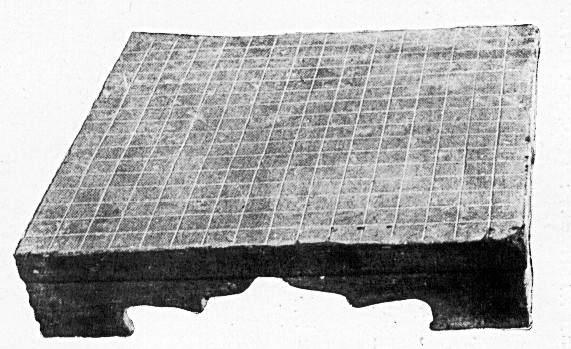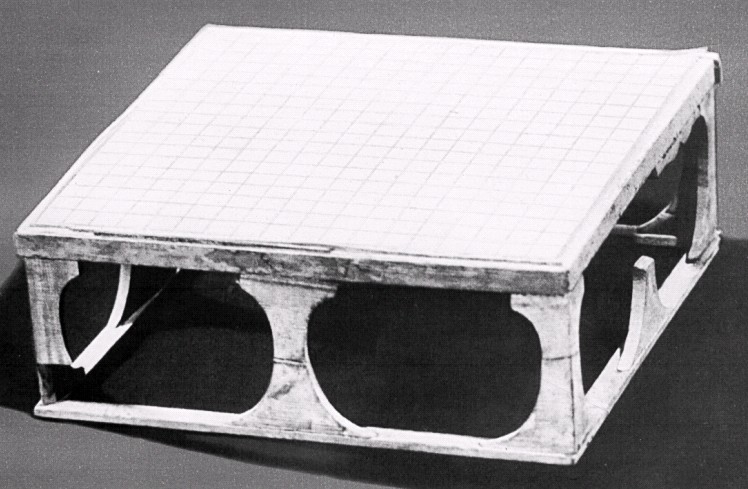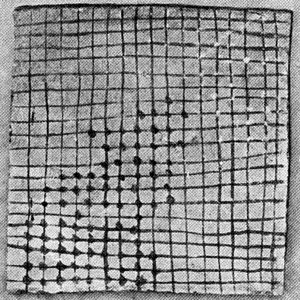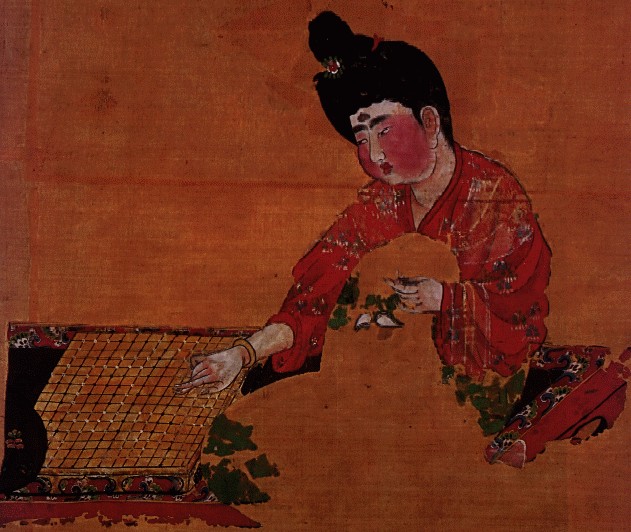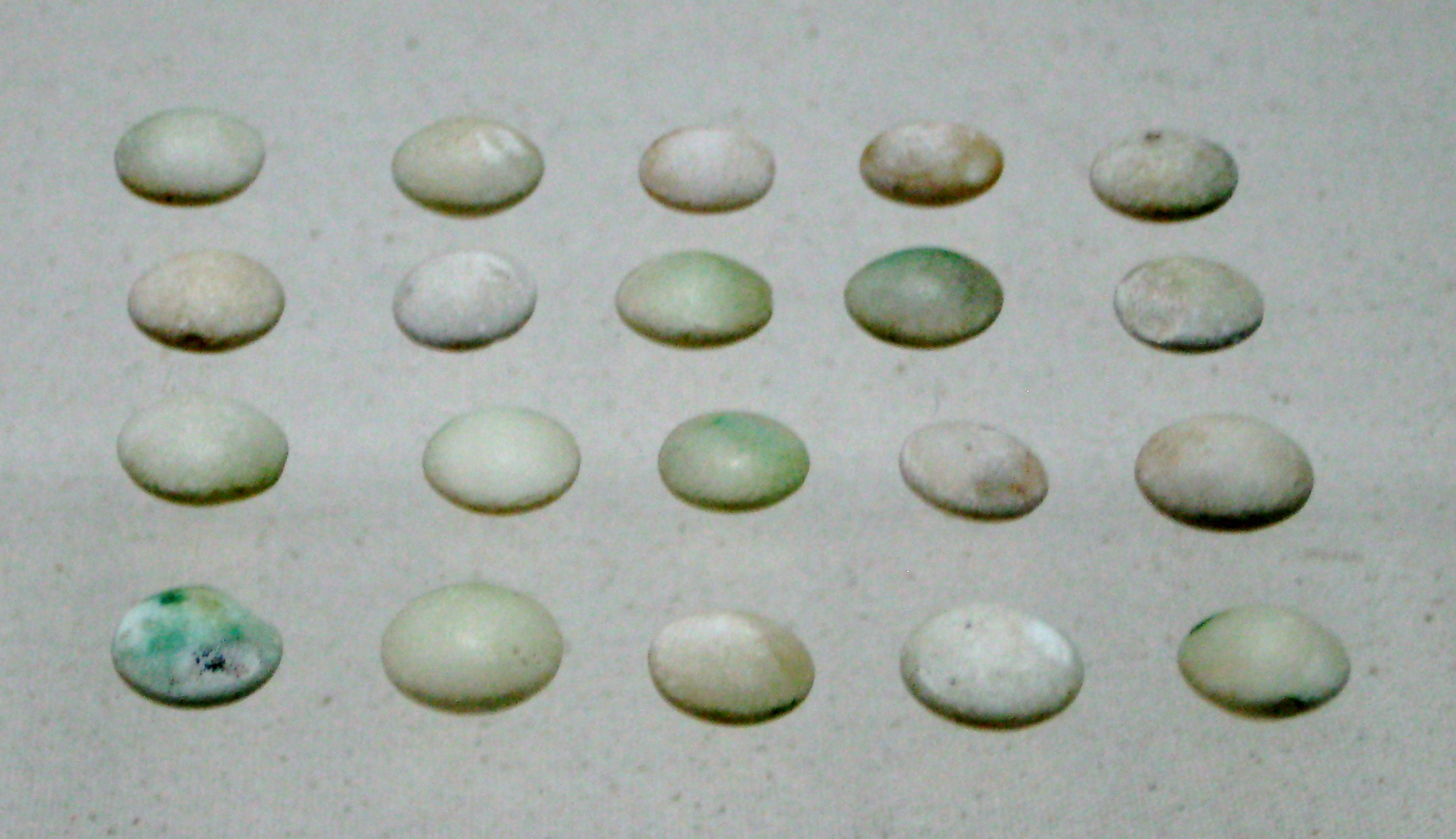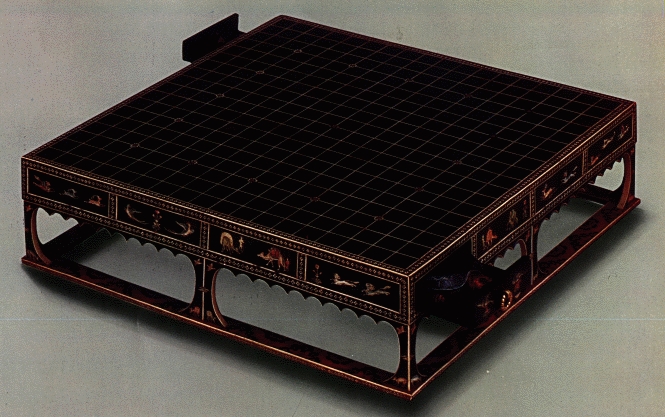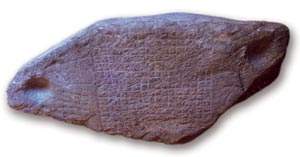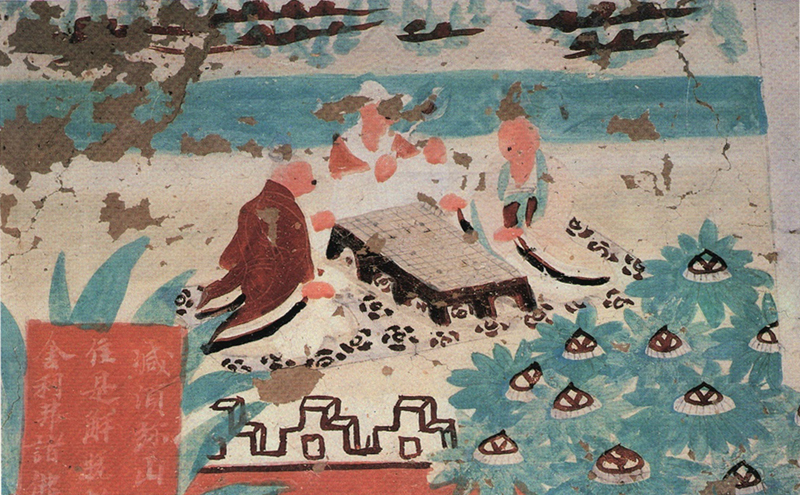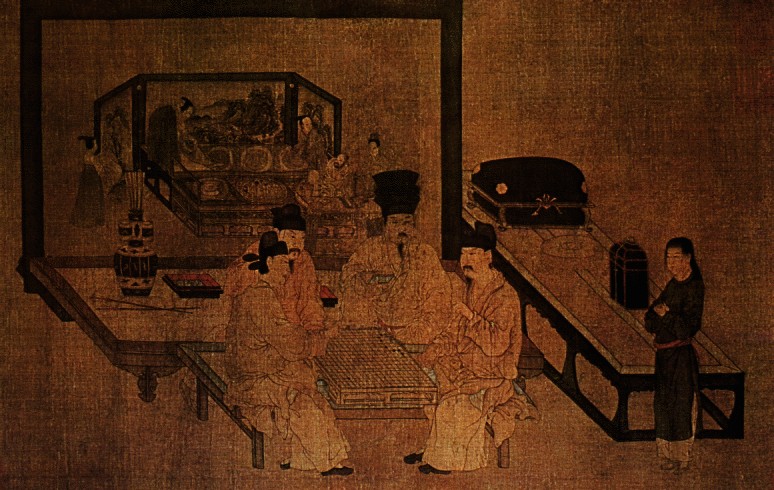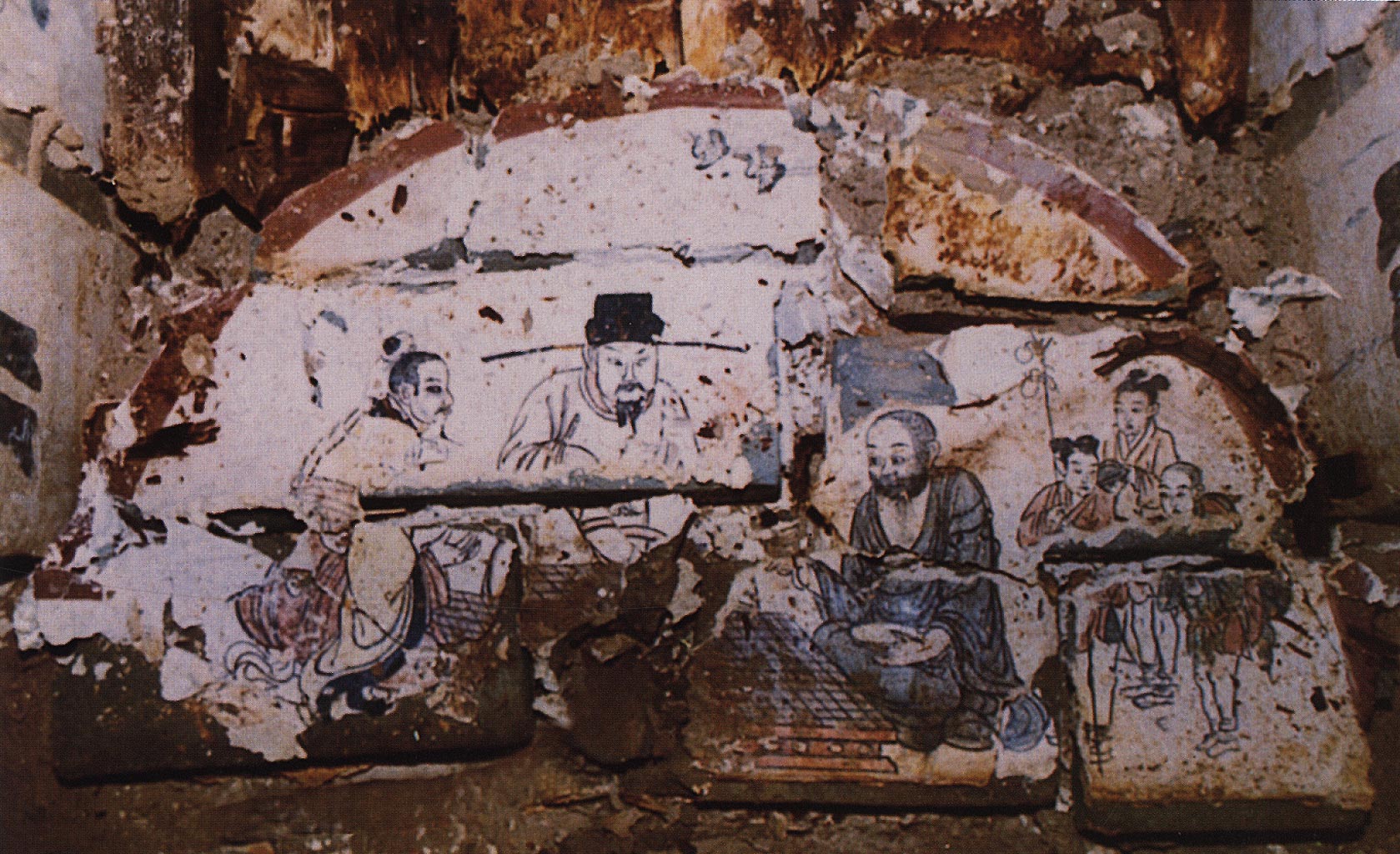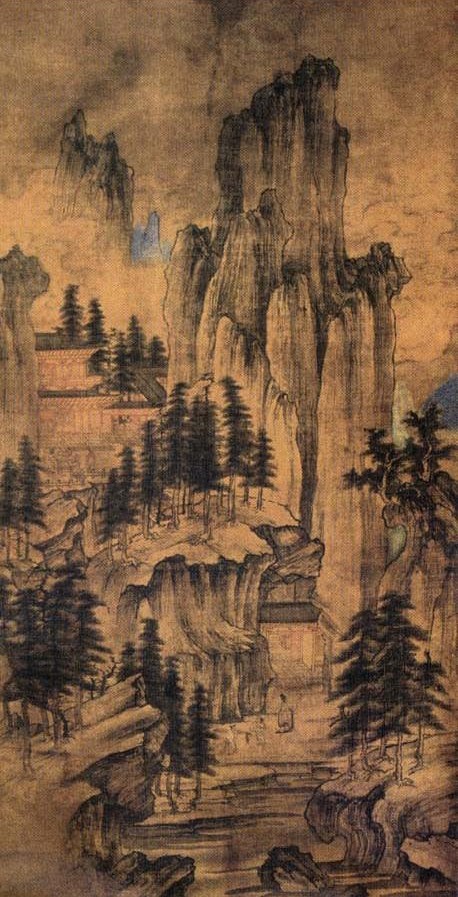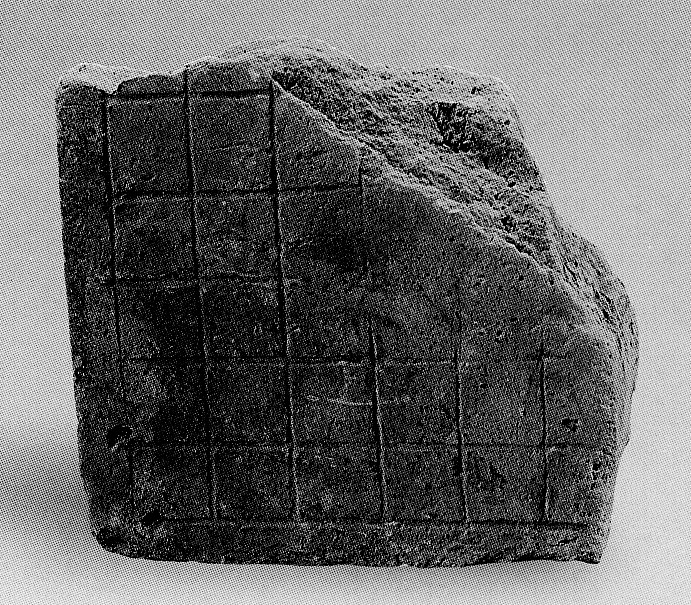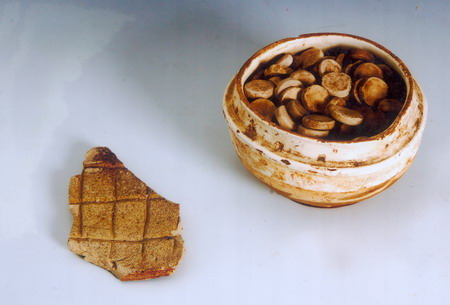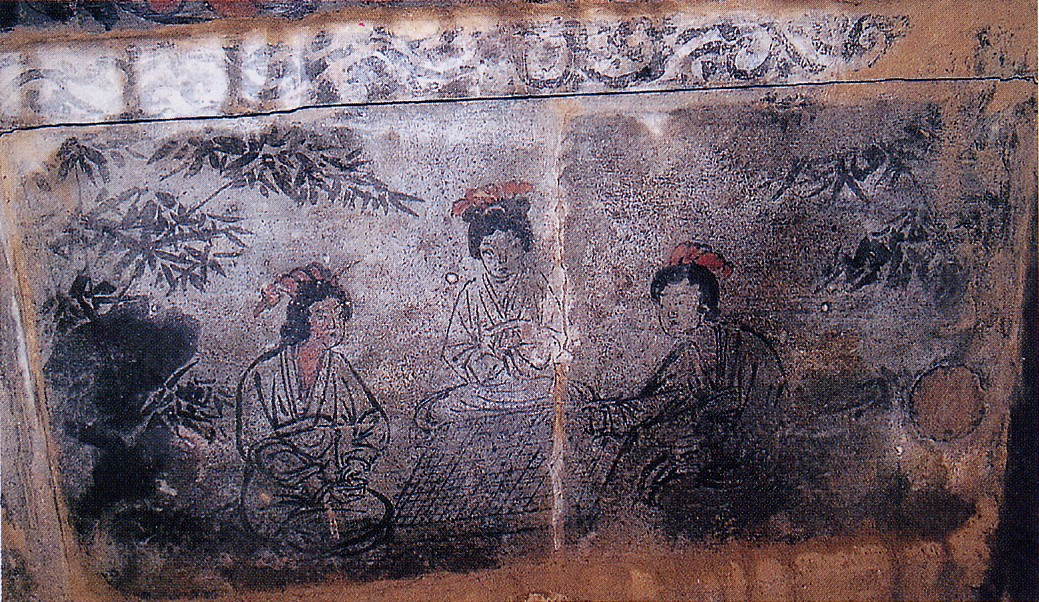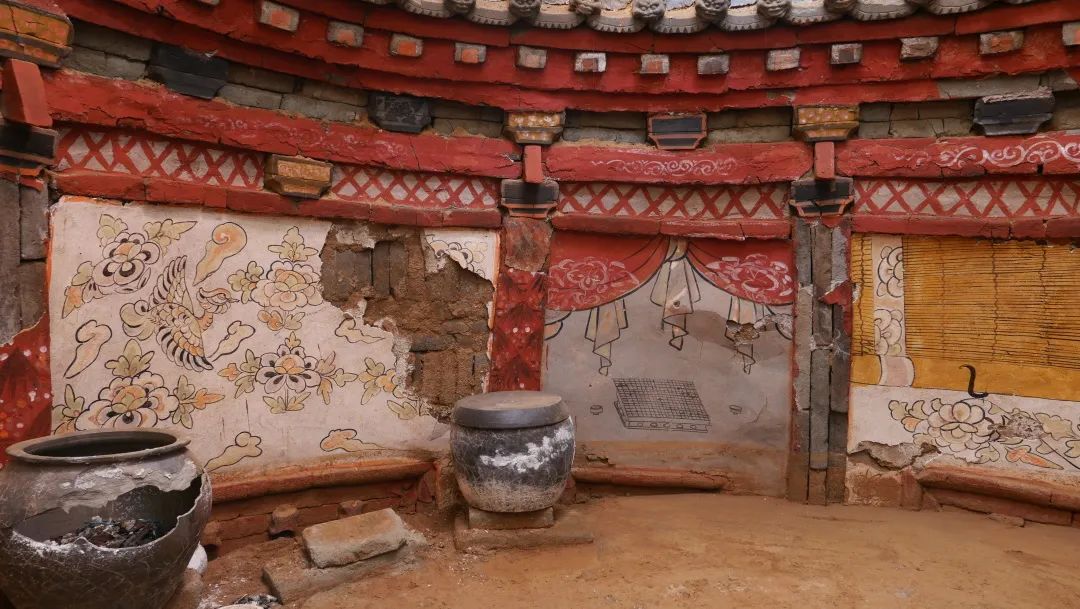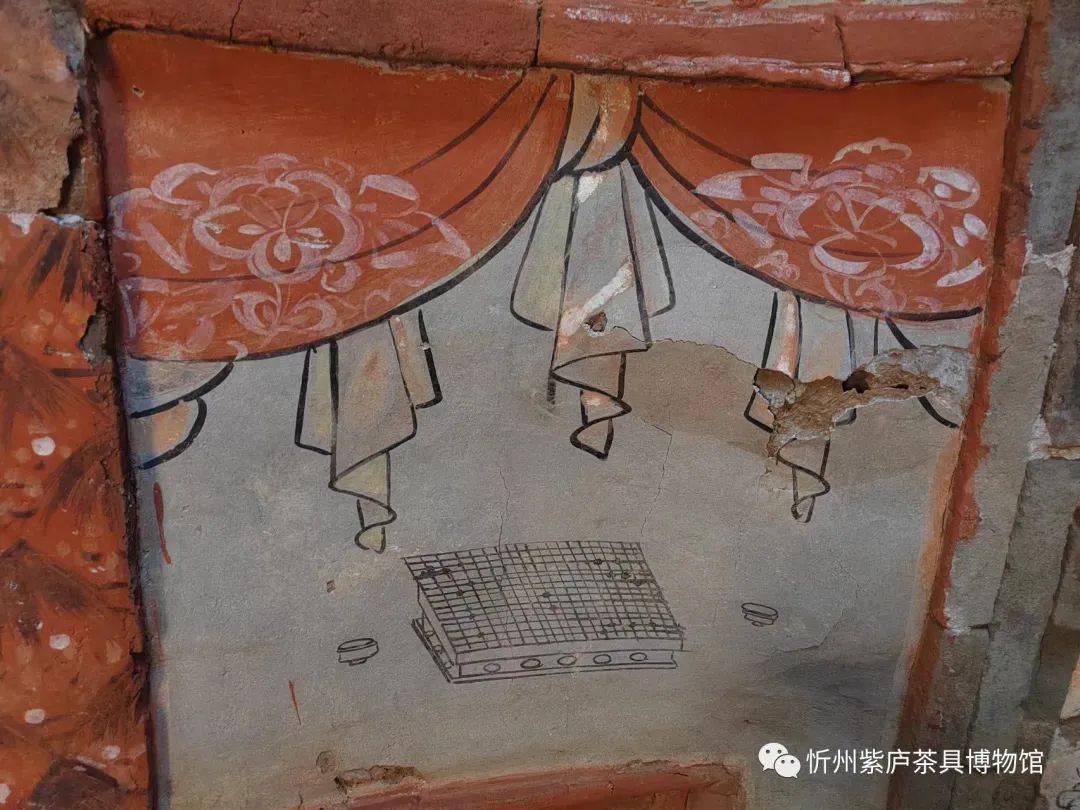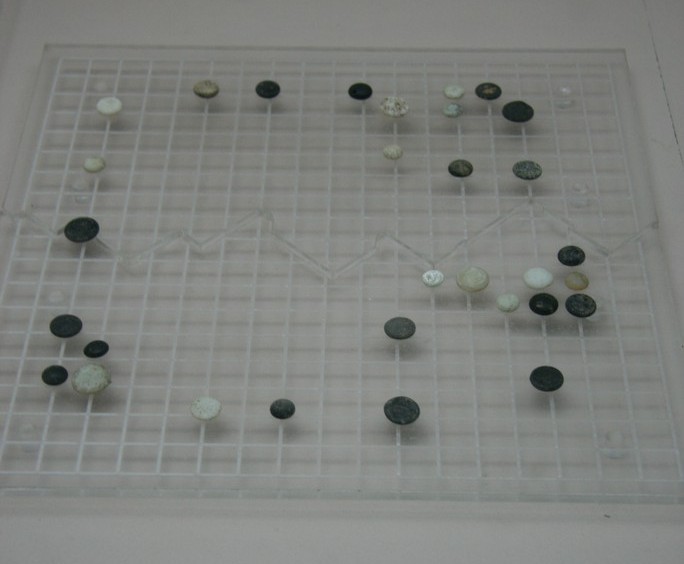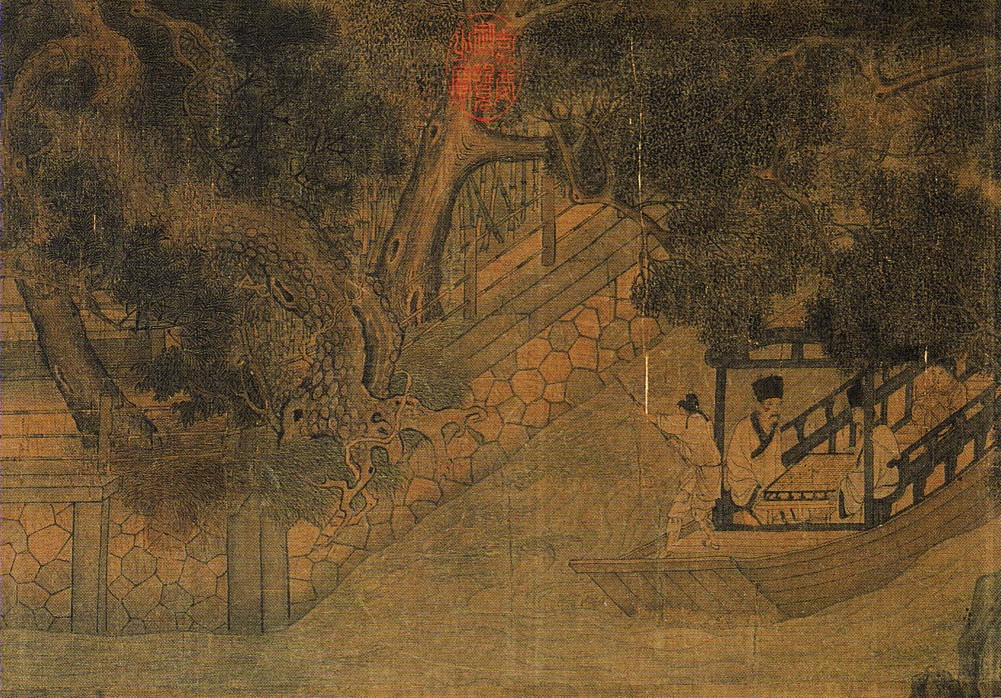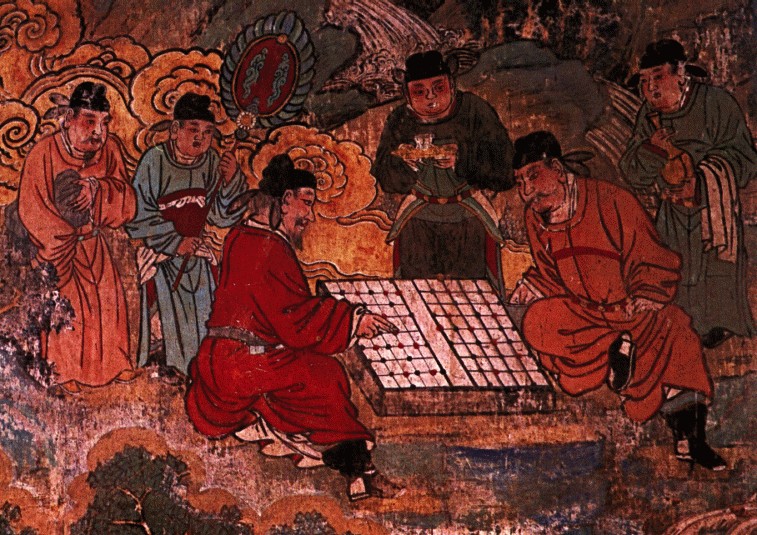BabelStone Blog
Wednesday, 15 April 2009
A Pictorial History of the Game of Go
For several years I have been collecting information relating to the early history of Chinese board games, which I have now decided to publish as a series of non-narrative posts over the next few weeks. I am starting with the game of Go (Chinese wéiqí 圍棋), which is perhaps not so interesting as it has already been done many times before (for example, see such sites as 中國圍棋史話, 古代围棋图片 and 围棋考古).
This page covers excavated Go boards and Go stones, as well as depictions of Go players, from the earliest times up until the end of the Yuan dynasty (i.e. up to 1368), and I will update it whenever I get any new information or better pictures. More pictures of old Go stones may be found at 中国古代围棋子演变简史 and 见证中国古代体育的围棋子.
There are a few points that are perhaps worth making.
Firstly, there is no archaeological evidence for the existence of Go prior to the Han dynasty (206 BCE – 220 CE). Han and Warring States period (476–221 BCE) tombs regularly contain Liubo 六博 boards and/or Liubo game pieces, but, despite the fact that Go stones should be more easily preserved than Liubo game equipment, no Go boards nor any certain examples of Go stones have ever been excavated from a pre-Han tomb, and only two or three examples of Han dynasty Go boards are known. And whilst there are scores of Han and pre-Han pictures and funerary figurines of Liubo players, there are no known depictions of Go playing until after the end of the Han dynasty. Despite this, many writers and web sites appear to show evidence that Go has been played in China for centuries or even millenia before the Han dynasty, for example pointing out examples of pre-Han pictures of Go playing or criss-cross images of Go boards on neolithic pots. But on closer inspection many of the supposed early pictures of people playing Go turn out to be depictions of people playing Liubo. And to my mind the criss-cross patterns on neolithic pots are simply decorative criss-cross patterns.
One particular example of such disinformation occurs in a set of Chinese postage stamps on the subject of ancient Chinese sports which was issued in 1986. This set of four stamps depicts what appear to be rubbings of Han dynasty picture bricks or picture stones, thus implying that each of the four sporting activities shown was the subject of artistic representation during the Han dynasty. The second stamp in this set shows two men playing Go on a (11×11 or 13×13 ?) Go board (unfortunately I only have a used copy of this particular stamp):
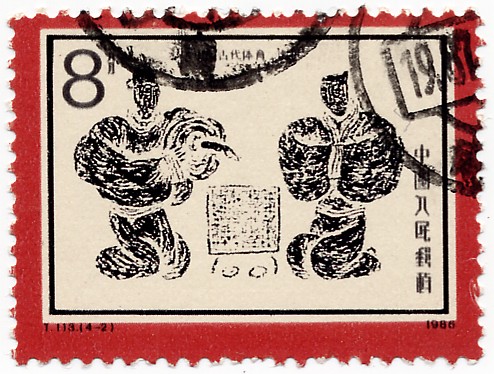
T113 (1986) "中国古代体育" (Sports of Ancient China) : Stamp 2 "围棋" (Weiqi)
[a modern fantasy in the style of a Han dynasty picture stone ?]
I have been unable to ascertain whether this and the other three images are based on actual Han dynasty stone or brick pictures or whether they are modern designs that are are merely in the style of Han stone pictures, but as I have never yet seen a Han dynasty picture of Go players I suspect that the design of the Go stamp must be a modern fantasy. There is also a 1993 Chinese stamp with a design showing ancient Go players, but this one is very similar to the picture of Go players in the Five Dynasties period mural from Yulin Cave 32 (shown further down this page), and so if it is not based on the Yulin Cave picture it must be based on some other mural from that period.
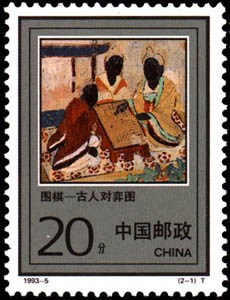
T 1993-5 (1993) "围棋" (Weiqi) : Stamp 1 "古人对弈图" (Ancients playing Go)
[design based on a Yulin Cave mural ?]
It is also tempting to see any unexplained small stones or beads that are found in tombs as examples of Go stones, but I would say that unless they are clearly divided into two colours and are approximately the right number for playing Go, or else are associated with a Go board or the decomposed remains of a Go board, then such finds should not automatically be assumed to be Go stones. On this basis I have excluded from this page a number of finds of "Go stones" that I do not believe are really Go stones.
Secondly, from the Tang through Yuan dynasties (618–1386) a surprisingly large number of excavated Go boards and paintings of Go players come from the peripheral regions of China or beyond China (Korea, Tibet, Xinjiang, and the territories of the Khitan, Tangut and Jurchen states), and relatively few examples have been found in tombs from central China, which at the very least shows that the game of Go was poular across a large geographic area and amongst many different nationalities. On the other hand the two earliest known boards both come from central China, and predate any boards from beyond China by half a millenium, and so I think that there is no reason to doubt that Go was invented in China.
Thirdly, the grid size of Go boards varies considerably. It has long been known that Go was originally played on a 17×17 grid (with 289 stones), and only developed to the now-standard 19×19 grid (with 361 stones) at later date. But not only do we find 17×17 and 19×19 boards, but we also find 13×13 and 15×15 boards, as well as very odd sizes such as 14×14 and 9×12. However, some of the boards found in tombs are miniature-sized model boards (only about 10cm. across) that have been specially made for use as funerary items, and so may not accurately reflect the grid size used on real boards.
Fragment of a Go Board from the Tomb of the Marquis of Haihun
海昏侯墓出土的棋板殘塊
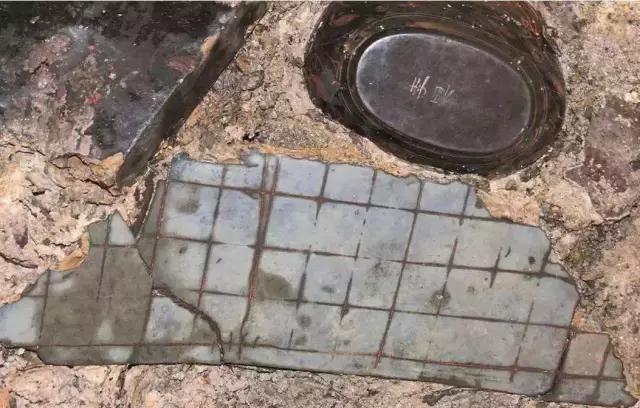
Source : 漢廢帝劉賀究竟什麼樣?也許我們都錯了! (2017-03-16)
(The item above the board is an inkstone)
Description : Fragment of a board engraved with a grid of horizontal and vertical lines resembling a Go board. I have not yet had access to an authoritative descrition of the object, and sources differ as to whether the board is made from laquered wood or from stone (it does not look like laquer, but if it was stone then the whole board should have survived). This board was found in the tomb of Liu He 劉賀 (died 59 BCE), a short-reigning Emperor of the Han dynasty who was deposed and exiled after just 27 days on the throne in 74 BCE. He was exiled to Haihun in modern Jiangxi, and given the title of Marquis of Haihun 海昏侯. His well-preserved tomb was discovered at Xinjian district of Nanchang in Jiangxi in 2011, and has proved to be the most important archaeological discovery in China during the first two decades of the 21st century.
Note 1 : This board has been identified by Chinese archaeologists as a fragment of a Go board, but I am not totally convinced this is necessarily the case. The surviving fragment does not have any star points marked, and there do not appear to be a large number of accompanying black and white stones, either of which would provide definitive evidence that it was a Go board. Of course, the lack of star points and Go stones do not prove that it was not a Go board, but it does open up the possibility that it was something else. One alternative suggestion put forward by Wang Jinzhong 王金中 is that the board is an early form of calculating board (suànbǎn 算板) on which beads were moved in order to make calculations. If this theory is true, then maybe the game of Go was devised during the Han dynasty by officials placing beads on a calculating board like this.
Note 2 : A text written on bamboo slips, entitled Five Colours Eating and Victory (wǔsè shíshèng 五色食勝) was also discovered in the tomb of the Marquis of Haihun. This text was originally believed to relate to divination with five kinds of food corresponding to the five elements, but more recently it has been interpreted as a manual for the board game of Liubo (see 《五色食勝》或揭開六博棋面紗). Although the title mentions five colours, apparently the text only mentions "black" (qīng 青) and "white" (bái 白), suposedly referring to Liubo game pieces. This theory seems very speculative, and I have not seen an edition of the text yet so I do not know what the exact details of the text, but if the board discovered in this tomb is a Go board then perhaps this text discusses the game of Go rather than Liubo.
Drawing of a bamboo slip from the book wǔsè shíshèng 五色食勝
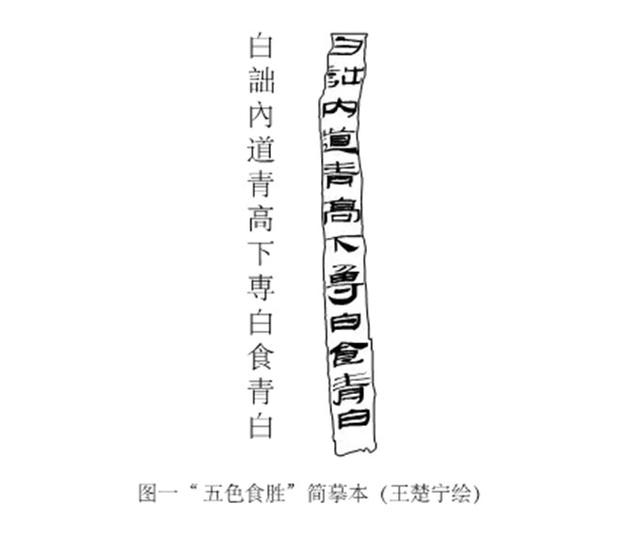
白詘内道,青高下専,白食青白
Date : Western Han, 59 BCE.
Size : 20.0 × 6.0 cm at the widest points.
Grid : Uncertain (fragment covers 13×4 lines). No star points are visible.
Fragment of Western Han Pottery Go Board
陽陵帝陵南闕門遺址出土漢代陶質圍棋盤殘塊
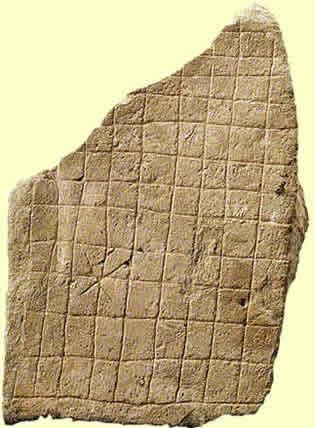
Source : 围棋考古 (2007-03-27)
Description : Fragment of a crude pottery Go board excavated during the 1990s from the site of the southern gate to the mausoleum of Emperor Jing Di 景帝 (reigned 156–141) and his consort at Yangling 陽陵 near Xianyang in Shaanxi province. Apparently this is not a purpose-made Go board, but a tile onto which a Go grid has been scratched (reportedly on both sides, but I have only seen pictures of the one side). Because of its crudeness, it has been suggested that it was used by guards at the mausoleum gate.
Date : Uncertain, as it is not associated with the main burial, but assumed to date to the Western Han period (206 BCE – 25 CE).
Size : 28.5 × 19.7 cm at the widest points.
Grid : Uncertain (fragment covers 13×10 lines). A star point is marked on the lower left corner, but no other star points are visible.
Eastern Han Stone Go Board
河北望都一號東漢墓出土石圍棋盤
Source : Wangdu Hanmu Bihua 望都漢墓壁畫 (Beijing, 1955)
(Click on image to see the face of the board)
Description : Stone Go board excavated in 1952 from the Han dynasty tomb M1 at Wangdu 望都 in Hebei province.
Date : Late Eastern Han period (25–220).
Size : 69 × 69 cm.
Grid : 17×17, with the five primary star points marked.
Western Jin Go Stones
山東鄒縣西晉劉寶墓出土圍棋子
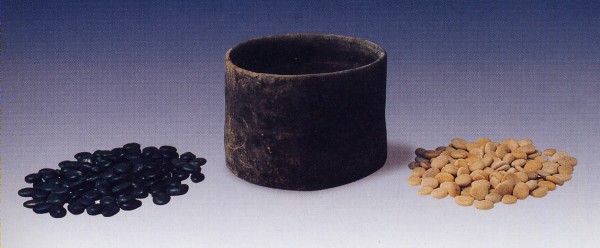
Source : Wenwu 文物 2005.1 page 9 fig.9
Description : A set of stone Go stones excavated in 1974 from the tomb of Liu Bao (died 301) near Zoucheng 鄒城 in Shandong province.
Date : Western Jin (265–317), 2nd year of the Yongkang 永康 era (301).
Stones : 232 or 289 (according to different sources) natural pebbles, half black half white, in a cylindrical pottery bowl, 12.4 cm in diameter and 9.0 cm in height.
Northern Qi Stone Monument depicting the Life of Buddha
北齊周榮祖造像碑
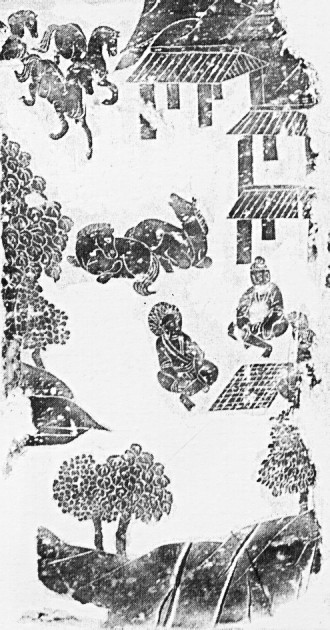
Source : Zhongguo Meishu Quanji 中國美術全集‧繪畫編 (Beijing, 1984) vol.19 plate 26
Description : Left side panel of an illustrated stone monument depicting the life of Buddha that was commisioned by Zhou Rongzu 周榮祖.
Date : Northern Qi (550–577).
Grid : 11×11.
Sui Dynasty Ceramic Go Board
河南安陽地區出土隋朝初年的白瓷圍棋盤
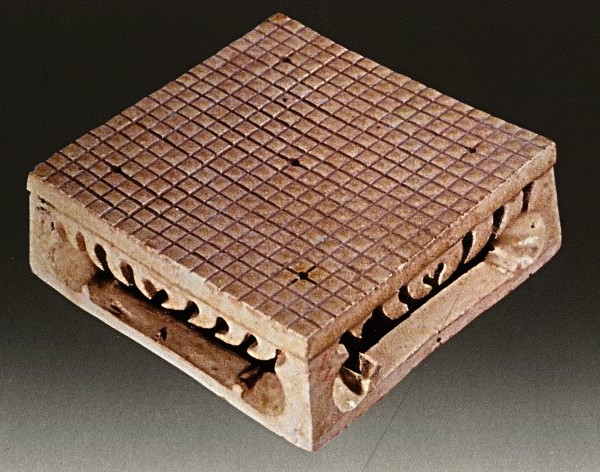
Source : Survey of Chinese Ceramics (Taibei, 1991) vol.2 page 171
Description : White ceramic Go board found near Anyang 安陽 in Henan province.
Date : Early Sui dynasty (581–618).
Size : 10.2 × 10.2 cm.
Grid : 19×19, with the five primary star points marked.
Tang Dynasty Go Board
重慶萬州區唐永徽五年駙馬冉仁才墓出土棋盤
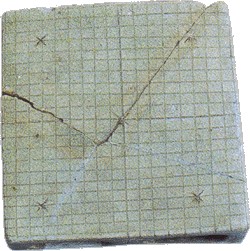
Source : 古代围棋图片
Description : Model Go board excavated from the tomb of Ran Rencai 冉仁才 at Wanzhou district 萬州區 in Chongqing.
Date : Tang dynasty (618–907) : 654.
Size : 11.0 × 11.0 cm.
Grid : 19×19, with the five primary star points marked.
Tang Dynasty Wooden Go Board
新疆阿斯塔那206號唐張雄夫婦合葬墓出土木圍棋盤
Source : Xinjiang Chutu Wenwu 新疆出土文物 (Beijing, 1975) plate 189
Description : Wooden Go board excavated in 1973 from the tomb of Zhang Xiong 張雄 (died 633) and his wife (died 688) (M206) at Astana 阿斯塔那 in Xinjiang (see Wen Wu 文物 1975.7).
Date : Tang dynasty (618–907) : 688.
Size :
Grid : 19×19.
Tang Dynasty Wooden Model Go Board
新疆阿斯塔那vii.2號唐墓出土木圍棋盤
Source : Aurel Stein, Innermost Asia (Oxford, 1928) vol. 3 plate XCIV
Description : Wooden model Go board with painted stones, found by Aurel Stein during excavations in January 1915 in an elaborate, two-chambered tomb (Tomb vii. 2) at Astana in Xinjiang (see Innermost Asia vol. 3 pp. 662–663, 704).
Date : Tang dynasty (618–907).
Size : 11.5 × 12.0 cm.
Grid : 19×22.
Tang Dynasty Pottery Go Board
湖南岳陽桃花山4號唐墓出土陶圍棋盤
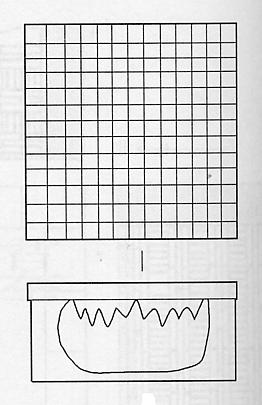
Source : Wen Wu 文物 2006.11 p.50
Description : Pottery model Go board excavated in 1994 from tomb M4 at Yueyang 岳陽 in Hunan province.
Date : Tang dynasty (618–907).
Size : 11.0 × 11.0 cm.
Grid : 14×14 !
Tang Dynasty Pottery Go Board
湖南湘陰唐墓出土陶圍棋盤
[No Image Available]
Source : Wen Wu 文物 1972.11 p.52
Description : Pottery model Go board excavated in 1971 from a tomb at Xiangyin 湘陰 in Hunan province.
Date : Tang dynasty (618–907).
Size : 8.0 × 8.0 cm.
Grid : 15×15.
Tang Dynasty Silk Painting of a Go Player
新疆阿斯塔那187號唐張禮臣墓出土絹畫屏風
Source : Zhongguo Meishu Quanji : Huihuabian 中國美術全集‧繪畫編 (Beijing, 1984) vol.2 plate 9
Description : Portion of a silk screen excavated from the tomb of Zhang Lichen 張禮臣 (M187) at Astana 阿斯塔那 in Xinjiang.
Date : Tang dynasty (618–907).
Grid : 17×16. This is probably a badly-drawn representation of a 17 × 17 board (the artist seems to have run out of space on the righthand side, so that the 16th vertical line is just squeezed in, but there is no room for the 17th). (Board Layout)
Tang Dynasty Go Stones
西安市郊區出土白石圍棋子20枚
CC-BY-SA-3.0 by Andrew West
Description : Stone Go stones excavated from the outskirts of Xi'an in Shaanxi province.
Date : Tang dynasty (618–907).
Stones : 20 white stones.
Korean Brick Go Board
韓國慶尚北道慶州市芬皇寺出土圍棋盤
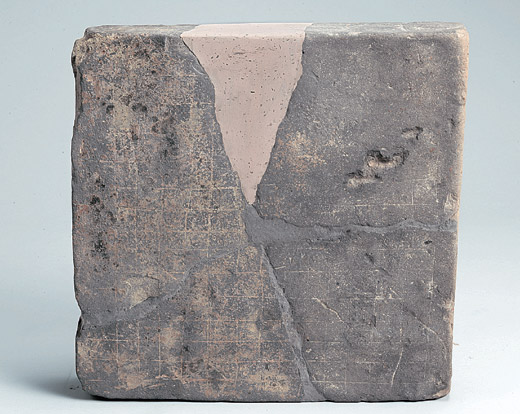
Source : netizenbonbu
Description : Brick Go board found in 2006 at the Bunhwangsa Temple in Gyeongju (the capital of the Silla kingdom) in Gyeongsangbuk-do province, South Korea. The board broke into three pieces on discovery, and one piece is missing.
Date : Unified Silla period (668–935).
Size : 43 × 42 cm.
Grid : 15×15.
Japanese Wooden Go Board
日本奈良正倉院藏唐朝紫檀木圍棋盤
Source : Nihon Bijutsu Zenshū 日本美術全集 (Gakken, 1978) vol.5.2 plate 18
Description : Lacquered wooden Go board preserved at the Imperial Storehouse (Shōsōin 正倉院) at Nara in Japan.
Date : Believed to have been imported from Chang'an in China during the Tang dynasty (618–907).
Size :
Grid : 19×19.
Tibetan Stone Go Board
西藏墨竹工卡縣加瑪鄉村強巴米久林宮殿遺址出土石密芒棋盤
[Click on image for a different view of the board]
Description : Crude stone Go board found in 2000 during the renovation of a house near the ruins of the Byams pa mi 'gyur gling བྱམས་པ་མི་འགྱུར་གླིང palace, the reputed birthplace of King Songtsän Gampo (617?–649), at rGya ma རྒྱ་མ in Maizhokunggar county in Tibet (see Guntram Hazod's The Royal Residence Pho Brang Byams Pa Mi 'Gyur Gling and the story of Srong bTsan sGam Po's Birth in rGya Ma in Tibet, past and present (proceedings of the Ninth Seminar of the International Association for Tibetan Studies, Leiden 2000) (Leiden, 2002) pages 27–47). The stone was resting against the wall of the house, but is presumed to come from the palace, as that was the source of building material for the house.
Note : In 1909 A. H. Francke found some stone slabs on which were carved chessboard-like grids at the ruins of an ancient castle at Chini in the upper Sutlej Valley in India (see Antiquities of Indian Tibet vol.1 page 12). He presumed that these were used for playing Tibetan Go (mig mang མིག་མང), but unfortunately he did not take any photographs or make any rubbings of the stones, so we camnnot be sure. Nevertheless, these two finds do suggest that Go-playing may have been an important feature of aristocratic life in early Tibet.
Date : Uncertain, but Guntram Hazod suggests that "the stone slab might have come from a very old stratum or even the foundation period" (i.e. the period of King Songtsän Gampo).
Size : 144 × 56 cm. (including a 10 cm wide hollow at each end to hold the Go stones).
Grid : 17×17.
Five Dynasties Mural from Yulin Cave 32
榆林窟第32窟北壁弈棋圖
Source : 古代围棋图片
Description : Mural from Yulin Cave 32 (in Guazhou 瓜州 county Gansu) illustrating the Vimalakirti Sutra 維摩詰經 (see Wenwu Cankao Ziliao 文物參考資料 1956.10).
Date : Five Dynasties period (907–979).
Song Dynasty Reproduction of a Five Dynasties Painting by Zhou Wenju
五代周文矩畫的《重屏會棋圖》
Source : Zhongguo Meishu Quanji : Huihuabian 中國美術全集‧繪畫編 (Beijing, 1984) vol.2 plate 61
Description : Song dynasty reproduction of a painting of Go players on a screen by Zhou Wenju 周文矩.
Date : Five Dynasties period (907–979).
Grid : 19×19.
Liao Dynasty Wooden Go Board and Stones
內蒙古敖漢旗白塔子遼墓出土圍棋具
[No Image Available]
Description : Wooden Go board and set of Go stones excavated in 1976 from a tomb at Aohanqi 敖漢旗 in Inner Mongolia (see Kaogu 考古 1978.2).
Date : Liao dynasty (907–1125).
Size : 40 × 40 cm.
Grid : 13×13.
Stones : 79 black and 76 white stones; 14 short of the expected 169 stones (Board Layout).
Liao Dynasty Go Board and Stones
遼寧錦西市孤山遼墓出土圍棋具
[No Image Available]
Description : Wooden Go board and set of Go stones excavated in 1984 from the tomb of Xiao Xiaozhong 蕭孝忠 near Jinxi 錦西 in Liaoning province.
Date : Liao dynasty (907–1125).
Size :
Grid :
Stones : 75 black and white pottery stones (presumably for use with a 13×13 board).
Liao Dynasty Go Stones
遼寧省凌源縣溫家屯遼墓出土陶質圍棋子82枚
[No Image Available]
Description : Set of Go stones excavated in 1979 from a tomb at Lingyuan 凌源 in Liaoling province (see Liaohai Wenwu Xuekan 遼海文物學刊 1994.1).
Date : Liao dynasty (907–1125).
Stones : 82 black and white stones (presumably for use with a 13×13 board).
Liao Dynasty Go Stones
遼寧朝陽市遼墓出土瑪瑙圍棋子
[No Image Available]
Description : Set of Go stones excavated in 1966 (or 1968?) from a tomb at Chaoyang 朝陽 in Liaoning province.
Date : Liao dynasty (907–1125).
Stones : 186 black agate and 186 white agate stones.
Mural from a Liao Dynasty Tomb
河北宣化7號遼墓壁畫
Source : Liao Mural Painting (Columbia University Art History & Archaeology Database) Item ID:24609
Description : Part of a mural in the tomb of Zhang Wenzao 張文藻 (d.1093) (M7) at Xuanhua 宣化 in Hebei province (see Wen Wu 文物 1996.9).
Date : Liao dynasty (907–1125) : 1093.
Grid : 13×13.
Silk Painting from a Liao Dynasty Tomb
遼寧法庫縣葉茂臺7號遼墓出土《深山會棋圖》
Source : 深山会棋图
Description : Silk painting from a Liao dynasty tomb at Faku 法庫 in Liaoning province. It shows a group of three people playing go. The motif of two go players and an observer derives from the story of a woodcutter who happens upon two immortals playing go deep in the mountains; the man is engrossed in the game, and when it is over and he goes back home hundreds of years have passed.
Date : Liao dynasty (907–1125).
Western Xia Brick Go Boards
拜寺溝西夏方塔出土磚圍棋盤
Source : Ningxia Institute of Cultural Relics and Archaeology, Bàisìgōu Xīxià Fāngtǎ 拜寺沟西夏方塔 [The Western Xia Square Pagoda at Baisigou] (Beijing: Wenwu Chubanshe, 2005) Plate XX no.3
Description : Three fragments (largest shown above) of brick Go boards discovered in the ruins of the Baisigou Square Pagoda, Helan County, Ningxia. One fragment is a corner with six grid lines in each direction; one fragment is unfinished, with no vertical grid lines on the right side.
Date : Western Xia (1038–1227).
Size : A) 21.3 × 22.0 × 7.0 cm; B) 18.0 × 10.0 × 5.0 cm.
Grid : Uncertain.
Western Xia Pottery Go Board Fragment and Ceramic Go Stones
西夏圍棋盤殘塊及圍棋子兩罐
Source : 西夏瓷推开一扇西夏窗
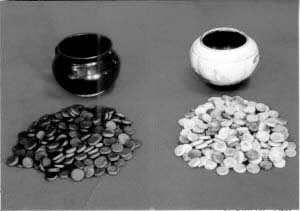
Source : 西夏围棋子
Description : Fragment of a pottery Go board, and a set of black and white ceramic Go stones in black and white ceramic bowls, These are in a private collection, and their source is unknown, although it can be reasonably surmised that they could only have come from a robbed tomb. A number of similar ceramic Go stones were discovered between 1983 and 1986 at the site of the Lingwu kiln 靈武窯 in Ningxia province.
Date : Supposedly Western Xia (1038–1227), but with no archaeological context this cannot be verified.
Grid : Uncertain, probably 19×19 from the number of stones.
Stones : Reportedly 200 black stones and 200 white stones, but not certain whether this is an approximate or an exact count.
Mural from a Jin Dynasty Tomb
陝西甘泉4號金墓壁畫
Source : Wenwu 文物 2009.7 page 38 fig.34
Description : Part of a mural in a tomb dated 1189 (M4) at Ganquan County 甘泉縣 in Shaanxi province (see Wen Wu 文物 2009.7). This is one of a set of four murals representing the four scholarly arts (琴棋書畫), all featuring female figures.
Date : Jin dynasty (1115–1234) : 1189.
Grid : 17×17 (?).
Mural from a Jin Dynasty Tomb
山西原平市南頭村1號金墓壁畫
Source : 文博中国 : 山西原平市南头村发现四座金元时期墓葬 (2023-03-14)
Source : 原平巿南头村发现金代壁画墓 (2022-11-28)
Description : Mural showing a Go board on a Jin dynasty tomb (M1) which was excavated at Nantou village 南頭村 near Yuanping City 原平市 in Shanxi in June-July 2022.
Date : Jin dynasty (1115–1234) : circa 1161-1232.
Grid : 19×14.
Jin Dynasty Go Stones
金上京出土圍棋子
Source : 围棋子 金代
Description : Go stones excavated from the site of the first Jin dynasty capital (Shangjing 上京) at Acheng 阿城 in Heilongjiang province.
Date : Jin dynasty (1115–1234).
Stones : 18 black and 14 white Go stones of various sizes.
Jin Dynasty Stoneware Pillow
金大定十八年磁州窯瓷枕
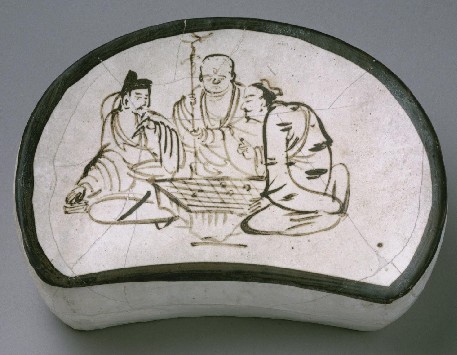
Source : Philadelphia Museum of Art 1957-26-1
Description : Cizhou ware stone pillow from the Jin dynasty.
Date : Jin dynasty (1115–1234) : 1178.
Southern Song Painting
《會昌九老圖》
Source : Gugong Bowuyuan Cang Wenwu Zhenpin Quanji [Jin Tang Liang-Song Huihua 3] 故宮博物院藏文物珍品全集 [晉唐兩宋繪畫 3] (Beijing, 2008) pages 168–175
Description : Handscroll in the Palace Museum Beijing that depicts a gathering in Luoyang during the Huichang period (specifically the year 845), including two men playing Go on a boat.
Date : Southern Song (1127–1279).
Grid : 19×19.
Northern Song Mural from Dunhuang Cave 454
莫高窟第454窟東壁維摩詰經變之場景
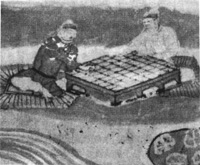
Source : 古代围棋图片
Description : Detail of a mural in Dunhuang Cave 454 illustrating the Vimalakirti Sutra 維摩詰經.
Date : Early Northern Song (960–1035).
Northern Song Go Stones
成都工地出土北宋圍棋子
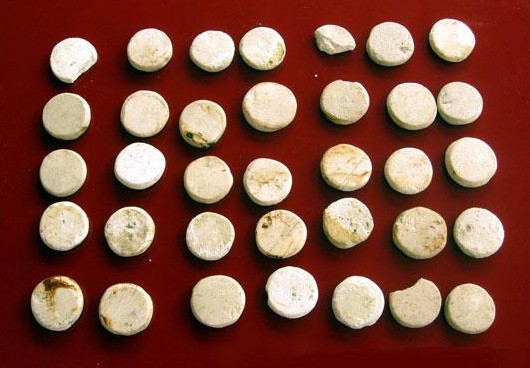
Source : 成都工地出土大量文物 發現千年圍棋子
Description : White Go stones discovered in 2009 in an ancient well at a construction site in Chengdu city in Sichuan province.
Date : Northern Song (960–1127).
Stones : About 30 white stones.
Yuan Dynasty Mural at the Lower Guangsheng Temple
山西省洪洞縣廣勝寺水神廟明應王殿壁畫
Source : Zhongguo Meishu Quanji : Huihuabian 中國美術全集‧繪畫編 (Beijing, 1984) vol.13 plate 83
Description : Detail of a mural at the Lower Guangsheng Temple 廣勝寺 in Hongdong 洪洞 county of Shanxi province (see Playing Go on a Chinese Chess Board).
Date : Yuan dynasty (1271–1368) : circa 1319–1324.
Grid : 9×12, apparently the board being used for playing Go is a non-standard Chinese Chess board (Board Layout).
Go Stones at the Liao Shangjing Museum
巴林左旗遼上京博物館藏圍棋子
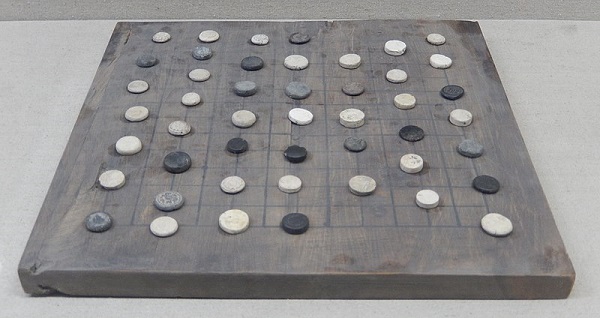
Source : Wikimedia Commons
Description : Mixed Go stones and Xiangqi pieces of various styles found in the Chinese City section of the Liao Superior Capital in Lindong, Inner Mongolia.
Date : Liao or Jin dynasty.
Stones : Various black and white stones.
Go Stones at the Khitan Museum
巴林左旗契丹博物館藏圍棋子
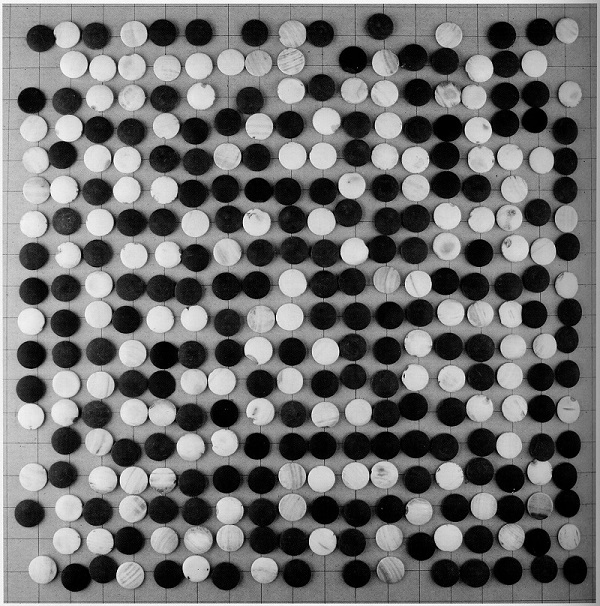
Source : Qìdān Yízhēn 契丹遺珍 [Treasures from the collection of the Khitan Museum] (Beijing, 2011) p. 174
Description : 354 clam shell and stone Go stones of unknown provenance.
Date : Unknown.
Stones : 172 white stones made from clam shells, and 182 black stones made from stone (2.2 mm diameter, 0.4 mm deep).
Go Stones at the Khitan Museum
巴林左旗契丹博物館藏圍棋子
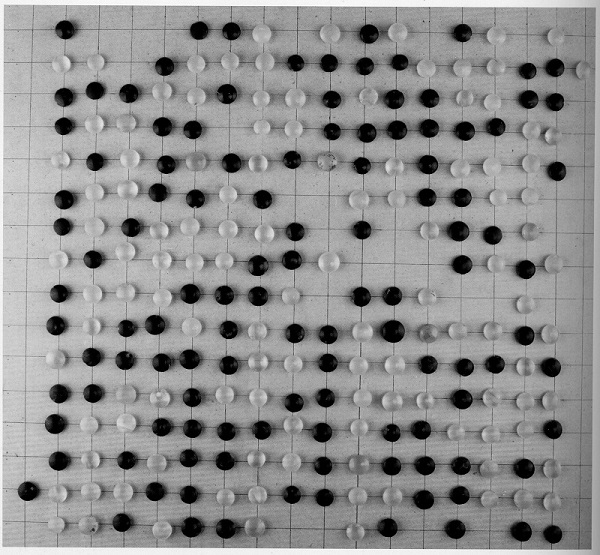
Source : Qìdān Yízhēn 契丹遺珍 [Treasures from the collection of the Khitan Museum] (Beijing, 2011) p. 176
Description : 280 agate Go stones of unknown provenance.
Date : Unknown.
Stones : 119 white stones and 161 black stones made from agate (1.4 mm diameter, 0.6 mm deep).
Go Stones at the Inner Mongolia Museum
內蒙古呼和浩特市內蒙古博物院藏元代圍棋子
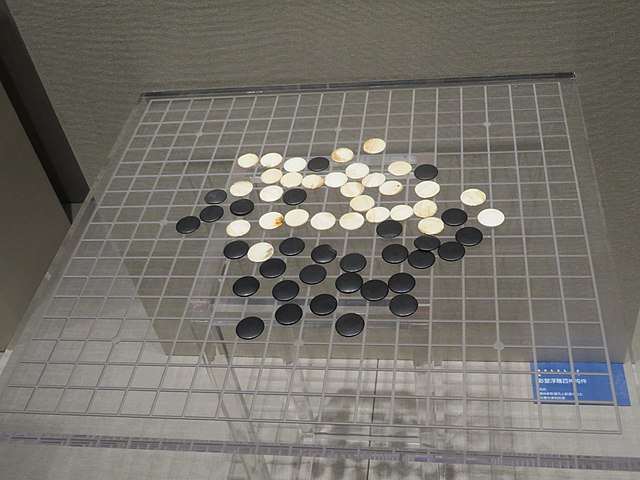
Source : Wikimedia Commons
Description : 30 black stones and 30 white stones of unspecified material and unknown provenance.
Date : Yuan dynasty.
Stones : 30 black stones and 30 white stones.
Last updated: 2023-03-14.
Index of BabelStone Blog Posts
